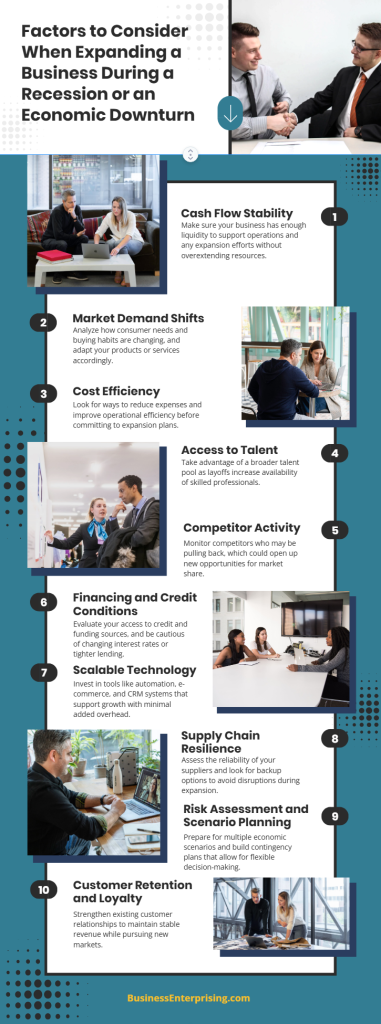
Learning from companies that have thrived during past recessions offers valuable insights. For instance, during the 2008 financial crisis, Amazon expanded its product offerings and invested in infrastructure, introducing Amazon Prime to create a loyal customer base and launching Amazon Web Services to capitalize on the growing need for cloud computing services. Similarly, Domino’s Pizza faced declining sales during the same period but responded with an honest marketing campaign addressing product quality, leading to revitalized brand image and increased market share. These examples demonstrate that with strategic planning and a focus on customer needs, navigating an economic downturn is achievable.
By embracing these strategies, you can not only weather economic challenges but also position your business for sustainable growth. Proactive adaptation and a commitment to innovation are key to turning adversity into opportunity.
Understanding the Risks and Opportunities of Economic Downturns
Economic downturns impact industries differently, presenting both challenges and opportunities. Understanding these dynamics can help you navigate and even find potential for expansion during uncertain times.
Certain sectors, like manufacturing, construction, agriculture, and consumer-driven industries such as retail and hospitality, often experience significant declines during recessions. Reduced consumer spending leads to decreased demand for non-essential goods and services, causing revenue drops and potential job losses in these areas.
Conversely, industries such as healthcare and logistics may demonstrate resilience or even growth. For example, during economic slowdowns, the healthcare sector often remains stable due to consistent demand, while logistics can benefit from shifts in supply chain strategies.
Common risks businesses face during downturns include reduced access to credit, as financial institutions may limit lending. This can hinder your ability to finance operations or expansion plans. Additionally, rising costs due to inflationary pressures can squeeze profit margins, making it essential to manage expenses carefully.
However, downturns can also unveil unexpected opportunities for agile and strategic companies. With decreased competition and lower asset prices, you might find favorable conditions for strategic investments or acquisitions. Moreover, shifts in consumer behavior during recessions can open new markets or demand for alternative products and services, allowing you to diversify and innovate.
By analyzing how economic downturns affect your industry and understanding the associated risks and opportunities, you can position your business to not only withstand challenges but also identify avenues for growth.
Strategic Planning and Financial Resilience
Effective strategic planning and financial resilience are essential for businesses aiming for expansion during uncertain times. Managing cash flow, engaging in scenario planning, controlling costs, and building financial buffers can help you grow without overextending resources.
Managing cash flow is fundamental to maintaining liquidity and ensuring you can meet financial obligations promptly. Regularly monitoring cash inflows and outflows allows you to identify potential shortfalls early and take corrective action. For instance, streamlining accounts receivable processes can accelerate cash collection, while negotiating favorable payment terms with suppliers can delay outflows, improving your cash position.
Engaging in scenario planning prepares you for various financial situations by modeling potential economic conditions and their impacts on your business. By analyzing best-case, worst-case, and most likely scenarios, you can develop strategies to address each situation effectively. This proactive approach enables you to respond swiftly to changes, maintaining stability and seizing opportunities as they arise.
Controlling costs is another critical component. Regularly reviewing and adjusting your expenses helps eliminate inefficiencies and reallocate resources to areas that drive growth. Implementing cost-saving measures, such as optimizing operational processes or renegotiating supplier contracts, can reduce expenditures without compromising product or service quality.
Building financial buffers, like an emergency fund, provides a safety net during revenue fluctuations or unexpected expenses. Maintaining reserves covering several months of operating costs ensures you can sustain operations and invest in growth opportunities, even during economic downturns.
By focusing on these strategies, you can position your business to pursue expansion during uncertain times, balancing growth ambitions with financial prudence.
Targeting New Markets and Diversifying Revenue Streams
Expanding into new markets and diversifying revenue streams can strengthen your business and reduce reliance on a single income source. By identifying underserved or emerging markets, you can uncover opportunities for growth and resilience.
To identify underserved markets, start by analyzing customer behavior and preferences. Look for gaps where needs are unmet or where existing solutions fall short. Conducting surveys, focus groups, and studying purchasing patterns can reveal these opportunities. Additionally, keyword research and monitoring online discussions can highlight areas lacking adequate products or services.
Assessing your competitors is also valuable. Identify segments they may have overlooked or inadequately served. By offering tailored solutions to these groups, you can establish a foothold in a less contested market.
Once you’ve identified a potential market, consider diversifying your offerings to meet its specific needs. This might involve developing new products or services that complement your existing portfolio. For example, if you sell fitness equipment, introducing related accessories or wellness programs could attract a broader customer base.
Expanding into new geographic areas is another strategy. Emerging markets often present less competition and a growing demand for innovative products. By adapting your offerings to local preferences and cultural nuances, you can effectively tap into these regions.
Diversifying revenue streams not only mitigates risk but also positions your business for sustainable growth. By proactively seeking and serving new markets, you can achieve expansion during uncertain times and build a more resilient enterprise.
Leveraging Technology and Digital Transformation
Investing in technology during economic downturns can significantly enhance your business operations and market reach. By adopting tools like automation, e-commerce platforms, customer relationship management (CRM) systems, and digital marketing strategies, you can streamline processes and connect with a broader audience.
Automation simplifies repetitive tasks, reducing errors and freeing your team to focus on strategic initiatives. For instance, automating inventory management can optimize stock levels, preventing overstocking and minimizing holding costs. Similarly, automating customer service through chatbots can provide instant responses to inquiries, improving customer satisfaction and retention.
E-commerce platforms open new revenue streams by allowing you to reach customers beyond your local market. An online store operates 24/7, providing convenience for customers and increasing sales opportunities. Integrating secure payment gateways and user-friendly interfaces enhances the shopping experience, encouraging repeat business.
CRM systems centralize customer information, enabling personalized communication and targeted marketing campaigns. By understanding customer preferences and behaviors, you can tailor your offerings to meet their needs, fostering loyalty and increasing lifetime value. Additionally, CRM analytics help identify trends and opportunities for upselling or cross-selling products and services.
Digital marketing extends your reach through channels like social media, email, and search engines. These cost-effective methods allow precise audience targeting and real-time performance tracking. By analyzing metrics such as engagement rates and conversion rates, you can refine your strategies to maximize return on investment.
Embracing these technologies not only streamlines operations but also positions your business for expansion during uncertain times. By enhancing efficiency and broadening your customer base, you can build resilience and drive growth despite economic challenges.
Talent Acquisition and Team Restructuring
An economic slowdown presents unique opportunities for your business to strengthen its workforce and enhance innovation. With many companies reducing staff, the talent pool becomes richer with skilled professionals seeking new opportunities. By strategically hiring during these periods, you can attract top talent that might be unavailable during more prosperous times. This approach not only fills existing gaps but also brings fresh perspectives to drive innovation and growth.
Additionally, reallocating internal resources can optimize your operations. Assess your team’s current structure to identify underutilized talents and areas where efficiency can be improved. By shifting employees to roles that better align with their skills and your company’s strategic goals, you enhance productivity without incurring additional costs. This internal mobility fosters a culture of adaptability and continuous improvement.
Moreover, focusing on core business functions during a downturn allows you to streamline processes and eliminate redundancies. This consolidation not only reduces expenses but also clarifies your company’s value proposition. With a leaner, more focused team, you’re better positioned to respond to market changes and customer needs effectively.
Investing in talent and restructuring your team thoughtfully during challenging economic times can set the foundation for sustainable growth. By leveraging the availability of skilled professionals and optimizing your internal resources, your business can achieve expansion during uncertain times and emerge more resilient in the face of future challenges.
Case Studies: Companies That Thrived in Tough Times
Economic downturns often present unique opportunities for businesses to innovate and expand. Several companies have not only weathered past recessions but have emerged stronger by adopting strategic approaches. Their experiences offer valuable insights for achieving expansion during uncertain times.
For example, during the 2008 recession, Netflix capitalized on the growing demand for affordable home entertainment. By shifting from a DVD rental service to a streaming platform, Netflix provided cost-effective entertainment options, leading to a significant increase in subscribers and establishing a dominant position in the industry.
Similarly, Groupon launched in 2008, offering consumers discounted deals on various products and services. This model appealed to budget-conscious customers, allowing Groupon to rapidly grow its user base and expand into multiple markets. By addressing consumers’ desire for value, Groupon turned economic challenges into opportunities.
Another example is Mailchimp, which began as a side project and gained traction during the late-2000s recession. Offering affordable email marketing services to small businesses, Mailchimp tapped into the need for cost-effective marketing solutions, leading to substantial growth and a strong market presence.
These cases demonstrate that understanding market needs and adapting business models accordingly can lead to successful expansion during uncertain times. By focusing on innovation and value, companies can transform challenges into opportunities for growth.
Conclusion
Navigating an economic downturn requires strategic foresight and adaptability. By focusing on cash flow management, scenario planning, cost control, and building financial buffers, you can position your business for resilience. Additionally, identifying underserved markets and diversifying your offerings can open new revenue streams, reducing dependence on a single income source. Investing in technology and digital transformation streamlines operations and broadens your market reach. Moreover, economic slowdowns present opportunities to attract top talent and restructure teams to strengthen core functions and foster innovation.
Learning from companies that have thrived during past recessions offers valuable insights. For instance, during the 2008 financial crisis, Amazon expanded its product offerings and invested in infrastructure, introducing Amazon Prime to create a loyal customer base and launching Amazon Web Services to capitalize on the growing need for cloud computing services. Similarly, Domino’s Pizza faced declining sales during the same period but responded with an honest marketing campaign addressing product quality, leading to revitalized brand image and increased market share. These examples demonstrate that with strategic planning and a focus on customer needs, expansion during uncertain times is achievable.
By embracing these strategies, you can not only weather economic challenges but also position your business for sustainable growth. Proactive adaptation and a commitment to innovation are key to turning adversity into opportunity.



